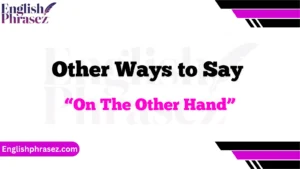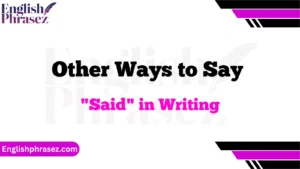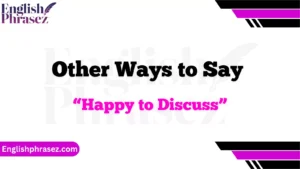When discussing contrasting ideas or viewpoints, the phrase “on the other hand” is often used to introduce an alternative perspective. However, variety in expression can enhance your writing or conversation, making it more engaging and dynamic.
This blog post explores 20 alternative phrases to convey the same concept, offering a range of expressions to suit different contexts. Whether you’re writing an essay, crafting a report, or simply engaging in thoughtful dialogue, these alternatives will help you articulate contrasting points with nuance and clarity.
Each phrase is accompanied by a detailed explanation and real-life example to illustrate its usage. Let’s dive into these diverse ways to enrich your communication!
Here is the list of 20 other ways to say “On The Other Hand”:
- Conversely
- In Contrast
- On the Flip Side
- Alternatively
- However
- Nonetheless
- Yet
- That said
- Alternatively Speaking
- In Comparison
- On the Contrary
- Inversely
- Still
- But
- On the Other Side
- Nevertheless
- While
- As Opposed To
- In a Different Light
- To the Contrary
1. Conversely
When comparing two ideas, “conversely” provides a formal way to introduce a contrasting viewpoint.
Meaning:
Indicates a direct contrast between two statements or ideas.
Tone:
Formal and analytical.
Explanation:
“Conversely” is used in academic or formal writing to show an opposing perspective.
Example:
“The new policy is beneficial for employees; conversely, it could increase operational costs for the company.”
2. In Contrast
This phrase is used to highlight the differences between two contrasting ideas.
Meaning:
Emphasizes the difference between two contrasting points.
Tone:
Neutral and informative.
Explanation:
Useful for drawing attention to how two elements differ.
Example:
“She loves urban living; in contrast, he prefers the tranquility of the countryside.”
3. On the Flip Side
A more informal way to present a counterargument or alternative perspective.
Meaning:
Introduces a less formal or casual counterpoint.
Tone:
Casual and conversational.
Explanation:
Often used in everyday conversations to present an opposing view.
Example:
“The job offers a high salary, but on the flip side, it requires long hours.”
4. Alternatively
A direct and straightforward way to introduce a different option or viewpoint.
Meaning:
Provides another option or perspective.
Tone:
Neutral and suggestive.
Explanation:
Often used to offer a different choice or viewpoint.
Example:
“We could go to the beach today; alternatively, we could visit the museum.”
5. However
A versatile connector used to introduce a contrasting idea.
Meaning:
Shows a contrast or exception to the previous statement.
Tone:
Neutral and formal.
Explanation:
Commonly used in both written and spoken English to present a differing opinion.
Example:
“The proposal is well-received; however, it faces several logistical challenges.”
6. Nonetheless
Used to present a contrasting idea despite the previous one.
Meaning:
Indicates that something is true despite the previous statement.
Tone:
Neutral with a slight formal touch.
Explanation:
Shows that despite previous information, the new point remains valid.
Example:
“The event was poorly attended; nonetheless, it was considered a success by those who came.”
7. Yet
An informal way to present a counterpoint or different view.
Meaning:
Introduces a contrasting idea or point that may contradict the previous one.
Tone:
Casual and conversational.
Explanation:
Often used in everyday speech to highlight an unexpected or contrasting point.
Example:
“He is very successful in his career; yet, he remains humble and approachable.”
8. That said
Used to introduce a contrasting point after acknowledging a previous statement.
Meaning:
Presents a counterpoint or nuance to the previously mentioned idea.
Tone:
Conversational and informal.
Explanation:
Often used to acknowledge a point before offering a contrasting view.
Example:
“The restaurant is renowned for its cuisine; that said, it can be quite expensive.”
9. Alternatively Speaking
A formal way to present a different perspective or option.
Meaning:
Introduces a different viewpoint or alternative.
Tone:
Formal and suggestive.
Explanation:
Suitable for formal discussions where alternative viewpoints are considered.
Example:
“The company can invest in new technology; alternatively speaking, it could focus on staff training.”
10. In Comparison
This phrase highlights the differences between two or more ideas.
Meaning:
Draws a comparison between contrasting elements.
Tone:
Neutral and analytical.
Explanation:
Useful for contrasting two elements in a detailed manner.
Example:
“The old model was inefficient; in comparison, the new model offers better performance.”
11. On the Contrary
Introduces a statement that opposes or contradicts the previous one.
Meaning:
Contrasts a previous statement with an opposing idea.
Tone:
Formal and emphatic.
Explanation:
Often used to strongly contradict or refute a previous statement.
Example:
“Some believe that technology is detrimental to education; on the contrary, it can enhance learning experiences.”
12. Inversely
Used to present a counterpoint that is opposite to the previous idea.
Meaning:
Indicates a reverse relationship or opposing viewpoint.
Tone:
Formal and analytical.
Explanation:
Useful in technical or analytical contexts to show a reverse correlation.
Example:
“The price of the product increases; inversely, the demand decreases.”
13. Still
A casual way to introduce a counterpoint or exception.
Meaning:
Introduces an idea that contrasts with or modifies the previous one.
Tone:
Casual and conversational.
Explanation:
Often used in everyday conversation to acknowledge a point while introducing a differing view. Example:
“The project is ahead of schedule; still, there are unforeseen challenges.”
14. But
A common and simple way to present a contrasting idea.
Meaning:
Indicates a contrast or exception to the previous statement.
Tone:
Casual and straightforward.
Explanation:
Widely used in both spoken and written English to show contrast.
Example:
“She enjoys the city life; but she finds the constant noise exhausting.”
15. On the Other Side
A less common phrase to present a different or opposing perspective.
Meaning:
Highlights an alternative or contrasting viewpoint.
Tone:
Neutral and informative.
Explanation:
Can be used to present a different side of an argument or situation.
Example:
“The policy benefits large corporations; on the other side, it may harm small businesses.”
16. Nevertheless
Used to present a contrasting idea that remains true despite previous information.
Meaning:
Introduces a point that stands despite the previous information.
Tone:
Formal and assertive.
Explanation:
Shows that despite previous points, the new statement is still valid.
Example:
“The weather was unfavorable; nevertheless, the event was a huge success.”
17. While
Used to introduce a contrasting statement or viewpoint.
Meaning:
Indicates a contrast between two statements.
Tone:
Neutral and formal.
Explanation:
Often used to compare two different aspects or viewpoints.
Example:
“The new design is innovative; while it is costly, it promises long-term benefits.”
18. As Opposed To
Introduces a contrasting idea by comparing two different situations or perspectives.
Meaning:
Highlights a difference or contrast between two options.
Tone:
Neutral and comparative.
Explanation:
Used to directly compare two differing points of view.
Example:
“The new method is time-consuming; as opposed to the old one, it is more precise.”
19. In a Different Light
Used to present an alternative viewpoint or interpretation.
Meaning:
Introduces a perspective that contrasts with the initial one.
Tone:
Reflective and suggestive.
Explanation:
Shows that an idea can be viewed differently from another perspective.
Example:
“The decision seemed unfair initially; in a different light, it was necessary for long-term stability.”
20. To the Contrary
Used to present a point that contradicts or refutes the previous statement.
Meaning:
Shows that the following statement contradicts the previous one.
Tone:
Formal and argumentative.
Explanation:
Often used to directly challenge or dispute a previous claim.
Example:
“The data suggests a rise in productivity; to the contrary, some departments have reported a decline.”
Conclusion
By utilizing these 20 alternative phrases, you can add variety and precision to your communication. Each option provides a unique way to present contrasting ideas, whether you’re writing an academic paper, crafting a business report, or engaging in everyday conversations. Choosing the right phrase can enhance clarity and ensure your message is delivered effectively. Feel free to experiment with these alternatives to find the ones that best suit your style and context.

Mia Clark is a linguist and writer dedicated to exploring the richness of the English language. Through her website, English Phrasez, Mia offers insightful and practical advice on mastering English phrases and expressions. Her passion for language and clear, engaging content make her a valuable resource for learners and enthusiasts alike.












